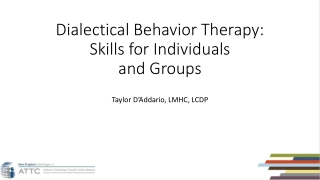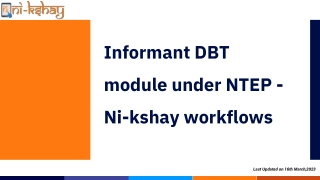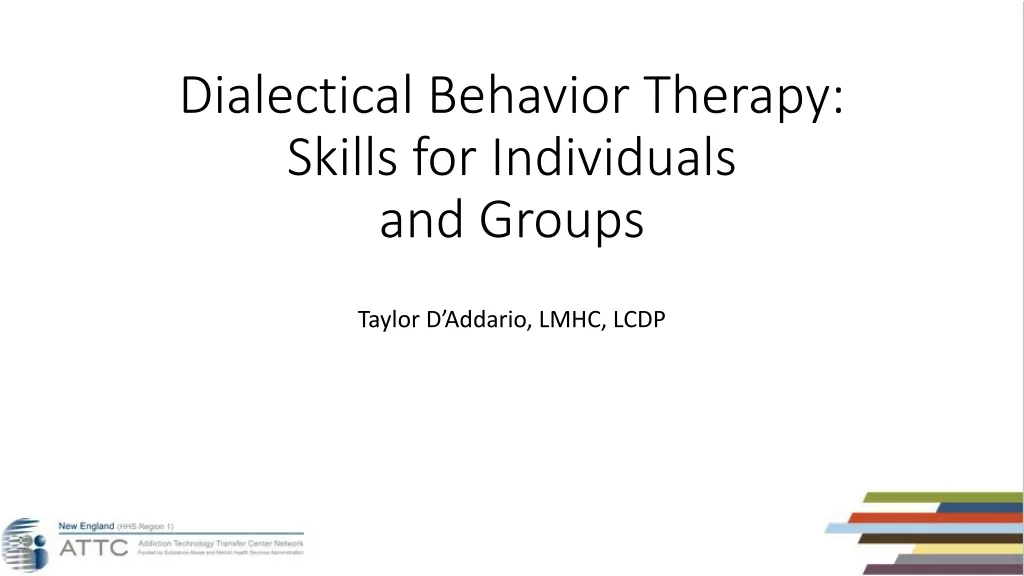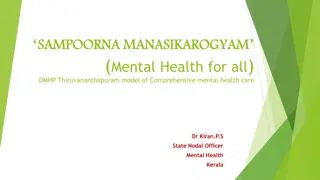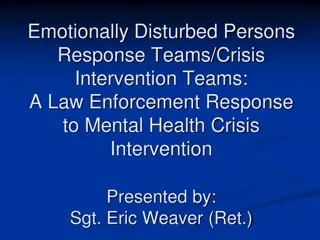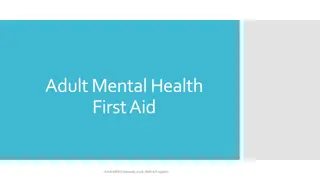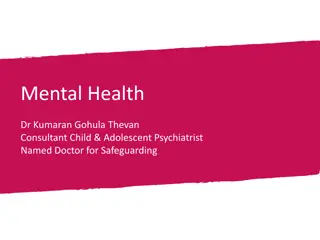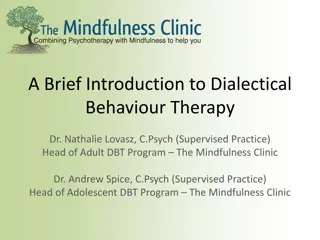
Effective Dialectical Behavior Therapy (DBT) at Trilogy for Mental Health
Discover how Dialectical Behavior Therapy (DBT) at Trilogy provides evidence-based treatment for clients struggling with various mental health challenges. Learn about the success of DBT in reducing suicidal behaviors, self-harm, and other risk factors, as well as its effectiveness in treating substance abuse, PTSD, eating disorders, and more. Explore the integrated care approach and diverse services offered by Trilogy, a not-for-profit behavioral healthcare organization in Chicago.
Download Presentation

Please find below an Image/Link to download the presentation.
The content on the website is provided AS IS for your information and personal use only. It may not be sold, licensed, or shared on other websites without obtaining consent from the author. If you encounter any issues during the download, it is possible that the publisher has removed the file from their server.
You are allowed to download the files provided on this website for personal or commercial use, subject to the condition that they are used lawfully. All files are the property of their respective owners.
The content on the website is provided AS IS for your information and personal use only. It may not be sold, licensed, or shared on other websites without obtaining consent from the author.
E N D
Presentation Transcript
Developed by Marsha Linehan for clients what were frequently hospitalized for suicidal ideation or behavior Dialectical Behavioral Treatment modality for dysresgulation in any of the following areas: What is DBT Affect Interpersonal Self Behavioral The theory of client struggles in DBT reflects the central dialectic of Acceptance vs Change
RCTs comparing DBT treatment to treatment as usual: Among females with BPD o DBT decreased risk for suicidal behaviors, suicide attempts, non suicidal self-injury (Verheul et al., 2003), (Linehan et al., 1993) Among adults with Cluster B Personality Disorders o Evidence Based Practice for Standard DBT o Decreased self-reported risk behaviors (Feigenbaum et al., 2012) Female Veterans with BPD o o DBT decrease NSSI, hospitalizations, suicidal ideation, dissociation, hopelessness, depression, anger suppression/expression (Koons et al., 2001) RCT comparing DBT to treatment by community experts (non-behavioral): DBT cut suicide attempts by 50% and inpatient hospitalizations by 73% (Linehand et al., 2006) o
Evidence Based Practice for Standard DBT Shown to be effective for: Substance abuse and dependence (Harned et al., 2009) Suicidal adolescents (Pistorello et al., 2012; McDonell et al., 2010; Rathus & Miller, 2002) PSTD due to childhood sexual abuse with and without co-morbid BPD (Bohus et al., 2013) Eating disorders co-morbid with substance abuse (Courbasson, Nishikawa, & Dixon, 2009) Eating disorders alone (Safer & Jo, 2010) Depression in older adults (Lynch et al., 2003)
Components of Standard DBT What is Dialectical Behavior Therapy (DBT)? (n.d.). Retrieved from https://behavioraltech.org/resources/faqs/dialectical-behavior-therapy-dbt/
Community Mental Health at Trilogy Not-for-profit behavioral healthcare organization Primarily funded through Medicaid Trauma-informed care Person-centered Varying levels of care Diverse population of clients Integrated approach Locations throughout Chicago
Community Mental Health at Trilogy Primarily provide outpatient and community- based services Integrated health services on-site Community outreach Medication training Case management Individual skill building and psychotherapy Group skill building and psychotherapy Specialized services Beacon
Team approach Consultation Strengths to providing Standard DBT in Community Mental Health Setting Integrated treatment Multiple locations Diverse population Individualized care
Barriers to providing Standard DBT in Community Mental Health Setting Limitations Resources Space Staff turnover Complexity of population Potential impact on client's ability to engage in treatment
Skills Training Group Specialized Components of DBT at Trilogy DBT Staff Consultation Individual Therapy Case Phone Coaching Management
Group Skill Building Component 1 Adapted to incorporate mindfulness and dialectics in each cycle Additional mindfulness groups offered as supplements Clients can join as each new cycle begins (like adolescent DBT) Meet clients were they are at and continue to challenge more growth Groups offered Foundations of DBT Module focused Integrated
Individual Therapy Component 2 Stage 1 focused Providing DBT as therapist within larger program services In combination with other individual therapy in and outside of Trilogy Mindfulness, EMDR, Yoga therapy, Psychotherapy
Phone Coaching Component 3 Most adapted components of Trilogy s Program Complement s agency s existing Crisis Line resource structure Excludes crisis intervention function of Traditional DBT Staffed by rotating clinicians participating in DBT consultation groups Clearly defining crisis within our context Coordination and consistency required
Case Management Component 4 Provided by primary team or clinician Managing therapy interfering behaviors Consultation to the client
Consultation Team Component 5 Individual consultation with in and outside providers Consultation with teams Multiple group consultation sections Beginner skill builders Trained skill builders Different locations
Role of DBT Coordinator Intra-agency referrals Screening Process McLean Screening Instrument Beginning Pre-treatment Commitment Strategies
Understanding our population Manuals Organization Allows for more in-depth material
ACT Team Fidelity Members of ACT Teams part of DBT program Allows for these clients to receive DBT services Able to inform team members on best practices utilizing DBT frame Opportunities to support clients with skills during outreach
Trainings offered from in and outside providers Trainings provided to staff outside of DBT program On-going didactic offered for beginner skill builders Training On-going consultation Opportunities to collaborate with teams
Outcome Measures Recently began collecting data Measuring Engagement in target behaviors Level of skill effectiveness Diary card for tracking Client report Skill trainer input
Impact of Specialized DBT Programming Greater access for clients More robust and stable DBT caseload Increased group offerings Stabilized staff consultation DBT frame informing other levels of service
DBT provider as sole therapist Expanding Stages of DBT treatment Where are we going? Continuing to reach more populations Graduating to Peterson DBT frame informing other services Outcome Measures & Data Extend Phone Coaching Hours?

